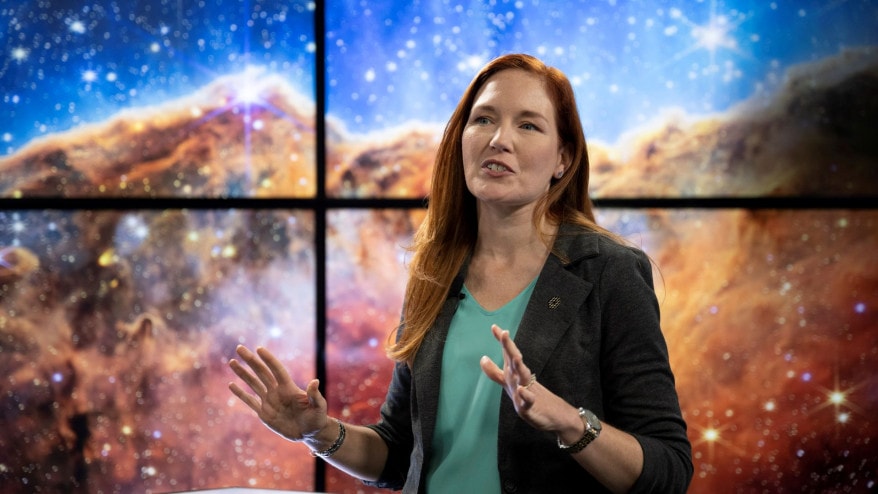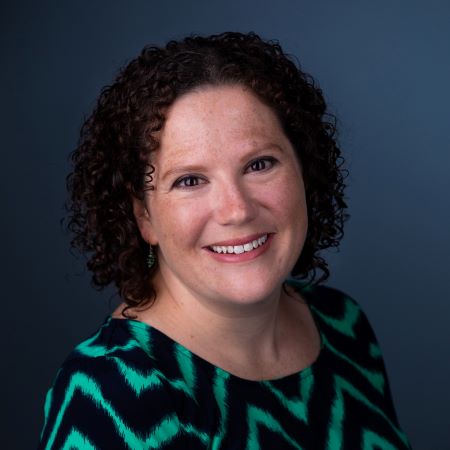KC’s Connection to the Heavens: Webb Telescope Images Trigger Elation Astronomers Call New Images a ‘Gold Mine’
Published July 13th, 2022 at 6:00 AM
Above image credit: This image released by NASA on Tuesday, July 12, 2022, combined the capabilities of the James Webb Space Telescope's two cameras to create a never-before-seen view of a star-forming region in the Carina Nebula. Captured in infrared light by the Near-Infrared Camera (NIRCam) and Mid-Infrared Instrument (MIRI), this combined image reveals previously invisible areas of star birth. (NASA, ESA, CSA, STScI | via AP)As pictures from the James Webb Space Telescope (JWST) popped up Tuesday in front of astronomers and space lovers in mid-America, their ecstasy bubbled over – prompted by new knowledge captured in the hauntingly beautiful images.
Some are suggesting mankind’s visual knowledge of creation on Tuesday took its biggest leap since Galileo crafted his telescope four centuries ago.
Academics at the University of Kansas, the University of Missouri, the University of Missouri-Kansas City and Benedictine College were contacted by Flatland just as the first images from the space telescope perched 1 million miles aloft were released in a flashy global media event.
Local astronomers and professors were effusive as they described work they will be doing – some for the rest of their careers – based on the data coming from the largest space telescope ever.
One local organization, the Astronomical Society of Kansas City, intends to use the flurry of interest in the space telescope to sprinkle a bit of “stardust” on young minds later this month.
Terry Conner, its president, said that the gorgeous images from the Webb are going to trigger a surge of interest in astronomy, particularly among young students.
“With the strong visuals, once you have their attention you can explain what they are seeing,” Conner said.
The society in late July will send an expert on the science behind the Webb telescope to meet with 200 elementary and middle school students of KCK School District USD 500 at a “Kids on Campus Day “ at the Kansas City, Kansas, Community College.
The Astronomical Society was launched in the 1920s and operates the Powell Observatory in Louisburg, Kansas. It is one of more than 600 local partners working to put on local events around the country to amplify the impact of the Webb telescope photos and discoveries. That effort is being coordinated by the office of public outreach of the Space Telescope Science Institute partnered with NASA.

Effusive Local Reactions
Working with the institute, Flatland obtained the names of local professors and scientists working with the Webb telescope. Here are some of their comments on Tuesday:
On Tuesday, vast distances of space evaporated, according to Elisabeth Mills, University of Kansas assistant professor of physics and astronomy.
“It made me feel like I could reach out and brush a cloud of interstellar gas – JWST is truly bringing the universe to us!” Mills said.
“It made me feel like I could reach out and brush a cloud of interstellar gas – JWST is truly bringing the universe to us!”
Elisabeth Mills, University of Kansas assistant professor of physics and astronomy
Hard work lies ahead.
“I am part of several teams making some of the first science observations with JWST. One of these (observed last week!) will look at the death spirals of stars dozens of times more massive than our sun,” Mills said.
“The other project, which will be observed late next year, will peer into the dusty center of two nearby galaxies that are practically ripping themselves apart by forming stars so intensely!” she said.
Her colleague Ian Crossfield, assistant professor of physics and astronomy at the University of Kansas, also said he now has his work cut out for him.
“I’m a member of the Science Council for a large team of over 100 astronomers around the world that will be obtaining some of JWST’s first and highest-quality data on exoplanets – planets orbiting other stars,” Crossfield said.
“After so many years of effort, it was thrilling to finally see JWST’s first data products start coming down to earth. The firehose of JWST data is flowing, and we’re all excited to start trying to drink from it,” Crossfield said.
Yicheng Guo, assistant professor of physics and astronomy at the University of Missouri in Columbia, modestly described himself as a “user” of the telescope.
“Along with the beautiful, eye-opening images, the powerful, unique infrared spectroscopy capability of Webb will reveal the physics that drives the life cycles (or ecosystem) of gas, dust and stars,” he said.
“What really strikes me is seeing the booming emissions from oxygen and neon from a very distant galaxy 13 billion years ago. My group has been trying to detect these emissions from nearby galaxies, but we got little. So my feeling, it’s like I am prospecting gold using a pan in a river, and somebody comes to say, ‘Hi, we found a gold mine, and we got a machine,’” Guo said.

Allison Kirkpatrick, assistant professor of physics and astronomy at the University of Kansas, wrote: “I will be using imaging and spectroscopy from the MIRI instrument to understand how supermassive black holes grew into the monsters we see today that are hidden at the heart of every massive galaxy.
“In the coming months, JWST will show us what our universe looked like in its infancy. Today represented fundamental progress towards answering the question, ‘Where did we come from?’ ” Kirkpatrick wrote.
At the University of Missouri-Kansas City, Benjamin Floyd, a graduate research assistant in physics and astronomy, said: “We are going to make spectroscopic measurements in the core of the Phoenix galaxy cluster in order to find out if nearby gas is cooling and flowing on to the central galaxy, which may be driving a huge burst of new stars to be made in the galaxy.
“JWST is a fantastic telescope that keeps exceeding our expectations. Both the calibration images we’ve been seeing over the last month or so and the gorgeous full-color images along with the spectroscopic results released today have completely shocked myself and many of my colleagues as to how amazing the data is!” Floyd said.
Christopher Shingledecker, assistant professor of physics and astronomy at Benedictine College in Atchison, Kansas, said his focus on the Webb telescope will center around the origins of life.
“I’m part of a team which will be among the first to use the JWST, with the observations beginning shortly. We hope to better understand whether prebiotic molecules – sort of the simplest building blocks of life – are present at even very early stages of star and planet formation. My role is to utilize state-of-the-art scientific models to understand the physical and chemical processes that could explain what we will see with JWST,” Shingledecker said.
Summing up for his associates across the region, he added this:
“I, like many of my colleagues, have been waiting years for this moment, so seeing these first images has been a thrilling experience for me. So much of my own research has been motivated by JWST, and like the Hubble Space Telescope, it will help to revolutionize our understanding of the universe,” he said.
Flatland contributor Martin Rosenberg is a Kansas City journalist who created and moderates the U.S. Department of Energy podcast, Grid Talk, about the future of electricity.


